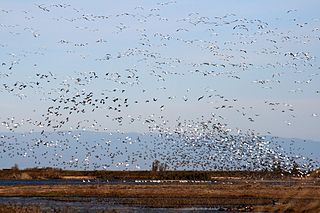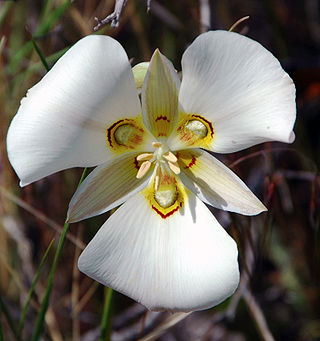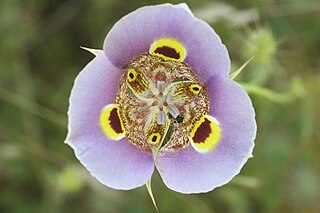Related Research Articles

Lemon Cove is a census-designated place (CDP) in the San Joaquin Valley in Tulare County, California, United States. The population was 308 at the 2010 census, up from 298 at the 2000 census.

The Sacramento National Wildlife Refuge Complex is part of the United States system of National Wildlife Refuges (NWR). It is located in northern California, in the valley of the Sacramento River.

Calochortus is a genus of flowering plants in the lily family. The group includes herbaceous, perennial and bulbous species, all native to North America.
Keyesville is an unincorporated community in Kern County, California. It is located 2 miles (3.2 km) west of Lake Isabella and the Kern River Valley, at an elevation of 2,848 feet (868 m). Keyesville, founded in 1854 is named for Richard M. Keyes, whose discovery of gold in 1853 started the Kern River Gold Rush.

The Greenhorn Mountains are a mountain range of the Southern Sierra Nevada, in California. They are protected within the Sequoia National Forest.

Big Chico Creek is a creek in northeastern California that originates near Colby Mountain in Lassen National Park. It flows 46 miles (74 km) to its confluence with the Sacramento River in Butte County. The creek's elevation declines from 5,000 feet (1,500 m) above sea level at its head to 120 feet (37 m) where it joins the Sacramento River, as shown on the Ord Ferry USGS quadrangle. Big Chico Creek forms part of the demarcation between the Sierra Nevada and the Cascade Range.

Calochortus tiburonensis, the Tiburon Mariposa lily, is a rare member of the genus Calochortus in the family Liliaceae. It is endemic to Marin County, California, where it is known only from one population on Ring Mountain east of Mill Valley. There it occurs on a single serpentine outcrop in grasslands from 50–150 metres (160–490 ft) in elevation.

Calochortus luteus, the yellow mariposa lily, is a mariposa lily endemic to California.
The Spenceville Wildlife Area is an 11,448-acre (46.33 km2) wildlife preserve managed by the California Department of Fish and Wildlife. It is located in the Sierra Nevada Foothills, within Nevada County and Yuba County of northern California.
Paynes Creek is a census-designated place (CDP) in Tehama County, California. It is 23 miles (37 km) east of Red Bluff. Its ZIP code is 96075 and telephone prefixes follow (530-597-xxxx), which is shared with the town of Dales, about 9 miles (14 km) to the west. Paynes Creek sits at an elevation of 1,949 feet (594 m). The 2010 United States census reported Paynes Creek's population was 57.

Calochortus amabilis is a species of the genus Calochortus in the family Liliaceae. It is also known by the common names Diogenes' lantern, yellow globe-tulip, golden globe-tulip, yellow globe lily, golden fairy lantern, golden lily-bell, Chinese lantern, and short lily.

Calochortus leichtlinii is a species of flowering plant in the lily family known by the common names Leichtlin's mariposa, smokey mariposa, and mariposa lily.

Calochortus persistens is a rare North American species of flowering plant in the lily family known by the common name Siskiyou mariposa lily. It is native to northern California and southern Oregon.

Calochortus superbus is a North American species of flowering plants in the lily family known by the common name superb mariposa lily. It is endemic to California, a common member of the flora in several types of habitat across much of the state. It is most abundant in the Coast Ranges and in the Foothills of the Sierra Nevada.
Dye Creek is an 18.2-mile-long (29.3 km) watercourse in Tehama County, California, United States, that is tributary to the Sacramento River. Dye Creek's watershed is situated in north-central California. The Dye Creek watershed contains rugged terrain areas of oak-studded forest, and also provides habitat for numerous understory flora and fauna. An example forb found in the watershed is the poppy Calochortus luteus, which is at its northern limit around the Dye Creek watershed.
Payne's Creek is a 33.7-mile-long (54.2 km) natural watercourse in Tehama County, California. The creek was apparently originally called Paines Creek according to an 1879 land survey map of the area. The town of Paynes Creek was named after the creek. The creek most likely was named after James S. Payne, the proprietor of a local sawmill.

Snell Valley is a depression landform in Napa County, California. This feature is located approximately five miles north of Aetna Springs. The valley is noted for its diversity of wildflowers, and within Snell Valley is the Missimer Wildflower Preserve. An example of wildflowers in Snell Valley is Gold Nuggets, Calochortus luteus.
Snell Creek is a 2.1-mile-long (3.4 km) watercourse in Napa County, California. It is situated approximately five miles north of Aetna Springs and is a tributary of Butts Creek, which ultimately merges into Putah Creek.
Lime Kiln Creek is a stream within Tulare County in central California. An alternative name for this creek is Dry Creek.
Panoche Pass is a mountain pass within the Diablo Range in San Benito County, California connecting the southern extremity of the Santa Clara Valley in the west to the Panoche Valley and San Joaquin Valley in the east. The name Panoche Pass is used for the United States Geological Survey quadrangle map for the local area. County Route J1, also known as the Panoche Road, traverses the pass.
References
- ↑ Mark R. Stromberg, Jeffrey D. Corbin and Carla Marie D'Antonio. 2007. California grasslands: ecology and management, page 149, 390 pages
- ↑ "4.5 Biological resources". General Plan Update - Draft Environmental Impact Report (Report). County of Napa. February 16, 2007. p. 15.
- ↑ C. Michael Hogan. 2009. Yellow Mariposa Lily: Calochortus luteus, GlobalTwitcher.com, ed. N. Stromberg